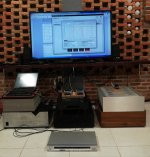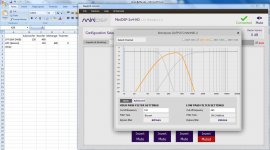...I will try and see if it possible to try and correct the phase with some extra software or device in the future...
One can take a few of ones favorite reference tracks and convolute them a reverse phase from actual speakers XO excess phase, although a note is members as mitchba and few others have reported its important that speaker system have the various summing transducer passbands accoustic centers time alligned, and imagine their observations can make sence to get it right.
So say accoustic centers is time alligned then formel is take your reflection free area measurement into REW and divide it its own minimum phase copy, then over in Rephase flatten that excess phase and output a impulse response that can convolute track material, for example JRiver can write tracks to disk in few seconds that is convoluted from that Rephase output and with those new track variants one can real time play back and compare reference track to that convoluted one. If you feel for such a test with convoluted tracks but feel nervous for actual procedure we can exchange more details over PM.
One can take a few of ones favorite reference tracks and convolute them a reverse phase from actual speakers XO excess phase, although a note is members as mitchba and few others have reported its important that speaker system have the various summing transducer passbands accoustic centers time alligned, and imagine their observations can make sence to get it right.
So say accoustic centers is time alligned then formel is take your reflection free area measurement into REW and divide it its own minimum phase copy, then over in Rephase flatten that excess phase and output a impulse response that can convolute track material, for example JRiver can write tracks to disk in few seconds that is convoluted from that Rephase output and with those new track variants one can real time play back and compare reference track to that convoluted one. If you feel for such a test with convoluted tracks but feel nervous for actual procedure we can exchange more details over PM.
As far as I know, you can only have perfect phase in one spot, when you add the room.
Fine offer - I might act on that 🙂
As far as I know, you can only have perfect phase in one spot, when you add the room...
Okay but then same can be said about a live instrument that its perfect phase is where the musician sits and not at a seat several meters away, and to replicate that situation for directive transducers then it should make sense get phase perfect (nearfield) on design axis will help for ratio of direct sound before ratio of room mix in.
I recall someone saying people can scare themselves looking at the time domain....and he was talking about electrical signals....🙂
As far as I know, you can only have perfect phase in one spot, when you add the room.
Fine offer - I might act on that 🙂
Just look at this post by Mitchba which shows the overlay of STEP shape of 6 different measurements:
https://www.diyaudio.com/forums/multi-way/271119-smooth-flat-vs-accurate-hi-fidelity-9.html#post4261806
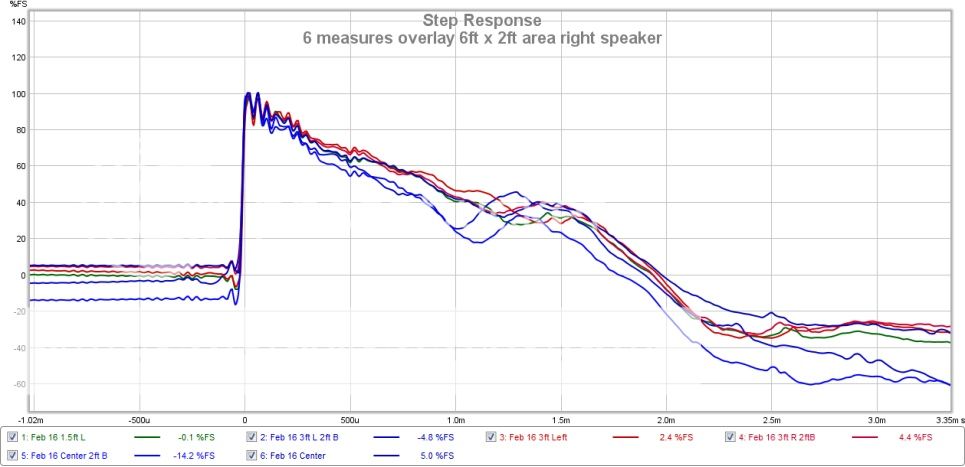
See how this time aligned and phase compensated multi-way is capable of keeping that relation at different points out in the room?
This is an older example of his setup, it shows that if you control the first reflections you actually get to keep that behavior over a pretty wide area. I guess with most multi-way speakers it would change by going up or down. But you need not fear it will only be valid for one point in space.
It's actually a smart move to base the phase correction on the average of a few measurements to prevent over compensation for local problems at one spot. Once you get the early reflections down far enough, your measurements won't differ as much anymore if you move a couple of inches.
It gets better if the speaker is build with low diffraction in mind and a good crossover policy. A speaker like the Synergies will still hold that STEP shape if you move up, down, left and right.
Last edited:
Okay but then same can be said about a live instrument that its perfect phase is where the musician sits and not at a seat several meters away, and to replicate that situation for directive transducers then it should make sense get phase perfect (nearfield) on design axis will help for ratio of direct sound before ratio of room mix in.
And this could be the reason why some measure the speaker alone, so that it is linear in both phase and amplitude, before you ad the room.
When I see measurements of Genuine Audio Neo, Buchardt and M2 - then my guess is that it's not a roomresponse - it's an anechoic response - that happens to work well in most rooms.
So when using programs like DRC. Why do they only suggest measuring in the listening position? And why use FIR in the lower octaves, when people from, lets say Trinov - clearly writes that they use FIR for the top and IIR for the low, to reduce latency.
DRC add's almost 1,4 seconds of delay - something that is simply not usable for my stero system, since I use for movies too.
I tried DRC. And it sounds good and I like how precise it measures. But I think it's very close with just manual adjustment in my IIR filter. And then I do not have problems with latency and extra programs for FIR - since my preamp has everything build in 🙂
But I will keep on playing with FIR - maybe I will learn something new and better with time.
Yes,
as you found out, DRC is great for 2.0 systems, but not when you add movie channels, then everything gets out of sync with the delay of processing.
DRC is to correct at the listening position. IIR is ok for correcting speaker/enclosure things like baffle step, or driver's break up, but DRC is used to correct (without trying to bash it into shape) some of the problems relating to phase and time issues in the room.
At my place, I use DRC when in 2.0 music listening, but regular IIR EQ when I am in movie mode, with minimal delay applied to corrections.
as you found out, DRC is great for 2.0 systems, but not when you add movie channels, then everything gets out of sync with the delay of processing.
DRC is to correct at the listening position. IIR is ok for correcting speaker/enclosure things like baffle step, or driver's break up, but DRC is used to correct (without trying to bash it into shape) some of the problems relating to phase and time issues in the room.
At my place, I use DRC when in 2.0 music listening, but regular IIR EQ when I am in movie mode, with minimal delay applied to corrections.
About Trinnov it may be because one of their consummer target is pro field where latency issues may ( in some cases )be a no no ( when tracking or overdubbing in the control room mains or nearfield are used as monitoring for musicians and technicians, if there is some ms of delay involved there will be issues).
If one is on a PC running FIR, I can't see the problem of delay and video sync. There are enough ways to solve that. I wouldn't want to live without my corrections, not even for movies, it's just too much fun!
While I do use DRC, I don't really care for the name of the program. I try to use it to control the early wave front that hits my listening position. Not use it as a tool to try and fix the room. Even though you can't really put a line between those two, I do believe the room should work with the speakers and vice versa to get the most out of this concept.
I can't see how creating the perfect speaker would work, if it is placed into a random room. I get that manufacturers simply have to do that. If we are willing, we can do better. Even the best speaker in the world would still need a good room to be the best it can be. If you're that serious about it all, there's no way around that.
I run 65536 tabs, plus another linear phase EQ and need 600 ms of sync correction for Video. While it isn't fit for "live music" unless one limits the latency, it's perfectly acceptable for playback of music and movies in my home.
Even Netflix can sync audio and video 😉.
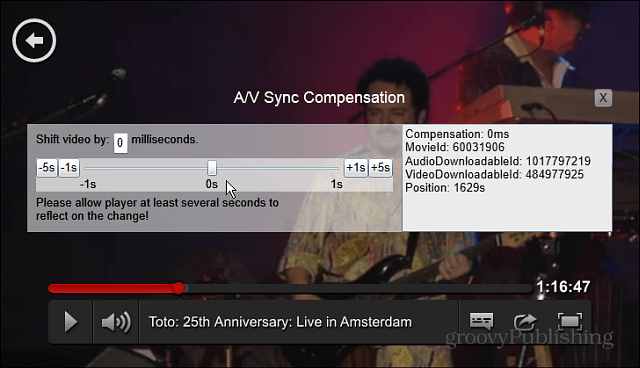
Source: Tweak Hidden Settings in Netflix for Smoother Streaming
While I do use DRC, I don't really care for the name of the program. I try to use it to control the early wave front that hits my listening position. Not use it as a tool to try and fix the room. Even though you can't really put a line between those two, I do believe the room should work with the speakers and vice versa to get the most out of this concept.
I can't see how creating the perfect speaker would work, if it is placed into a random room. I get that manufacturers simply have to do that. If we are willing, we can do better. Even the best speaker in the world would still need a good room to be the best it can be. If you're that serious about it all, there's no way around that.
I run 65536 tabs, plus another linear phase EQ and need 600 ms of sync correction for Video. While it isn't fit for "live music" unless one limits the latency, it's perfectly acceptable for playback of music and movies in my home.
Even Netflix can sync audio and video 😉.

Source: Tweak Hidden Settings in Netflix for Smoother Streaming
I get that the sync can be done between audio and video.
Most video players will allow that.
The trouble is when there's DRC applied to the Mains L/R channels, but either a lighter / different DRC or no DRC at all on the Center, Surrounds R/L and Sub(s).
Then, there's a time delay between the mains and the rest.
You'll have to find a way to adjust the timing between the Towers and your new stereo Subs when you start getting them to play together, wesayso.
Most video players will allow that.
The trouble is when there's DRC applied to the Mains L/R channels, but either a lighter / different DRC or no DRC at all on the Center, Surrounds R/L and Sub(s).
Then, there's a time delay between the mains and the rest.
You'll have to find a way to adjust the timing between the Towers and your new stereo Subs when you start getting them to play together, wesayso.
I can't imagine that becoming a problem. I already run 6 separate FIR channels as is. As long as there is one clock responsible for timing and you make sure to use FIR filters with the same tab count and peak position, there won't be a different delay compared to other channels. My subs won't be running without their own compensation anyway.
If you use a different or lighter DRC recipe on each of the other channels, just make sure to edit the FIR file to have the same length overal and use the same positioning of it's peak. I've done RePhase edits on FIR files and other surgery but always make sure the FIR file is composed exactly like the other channels. That's the trick to make it work on as many channels as you'd like.
Try it sometime, once you know what to look for, it isn't that hard. I do use a configuration file to make sure each channel gets what is needed.
For JRiver you can use the configuration schematic from convolver:
Config file
You can make it as complicated as you'd like, have different FIR files for each sample rate etc. I use one sample rate and let JRiver handle the conversion between those formats. More info here: Convolution - JRiverWiki
Sorry to mess up this topic with this info, if you need more we could move it to another thread.
If you use a different or lighter DRC recipe on each of the other channels, just make sure to edit the FIR file to have the same length overal and use the same positioning of it's peak. I've done RePhase edits on FIR files and other surgery but always make sure the FIR file is composed exactly like the other channels. That's the trick to make it work on as many channels as you'd like.
Try it sometime, once you know what to look for, it isn't that hard. I do use a configuration file to make sure each channel gets what is needed.
For JRiver you can use the configuration schematic from convolver:
Config file
You can make it as complicated as you'd like, have different FIR files for each sample rate etc. I use one sample rate and let JRiver handle the conversion between those formats. More info here: Convolution - JRiverWiki
Sorry to mess up this topic with this info, if you need more we could move it to another thread.
Last edited:
I wonder how this alignment would transfer to a 4 way system. Or I may try the upper 3 bands as in the first post plus LR24 below.
Sorry, my mind read you wanted to try this passively.
Then yes, I believe X has tried a 3-way using the Harsch XO. As long as you have 8 channels of DSP outputs, and the amps to power all that.
Then yes, I believe X has tried a 3-way using the Harsch XO. As long as you have 8 channels of DSP outputs, and the amps to power all that.
Yes, that is what I have now, using two t.racks DSP 4x4 mini. Standard LR24 on all 4 bands right now. I think I will try the 3 upper bands as Harsch and keep the lowest LR24.
I wonder how to measure and what to look for in the measurements. I have REW and UMIK and can do the basic stuff. I still fight with filtering out the room (how to set the windows) and then how to interpret GD and impulse plots...
I wonder how to measure and what to look for in the measurements. I have REW and UMIK and can do the basic stuff. I still fight with filtering out the room (how to set the windows) and then how to interpret GD and impulse plots...
Follow the recipe for the Harsch XO.
With your mic and REW, look at the impulse window, and tweak the delay the upper driver to get a nice clean impulse. You will see what's happening on the window, when trying some values up or down.
Do the first XO, then move to the next one, aligning everything.
With your mic and REW, look at the impulse window, and tweak the delay the upper driver to get a nice clean impulse. You will see what's happening on the window, when trying some values up or down.
Do the first XO, then move to the next one, aligning everything.
I wonder how this alignment would transfer to a 4 way system. Or I may try the upper 3 bands as in the first post plus LR24 below.
I didn't even remember that I tried this in a 3-way. And it seemed to work if you look at the Step response.
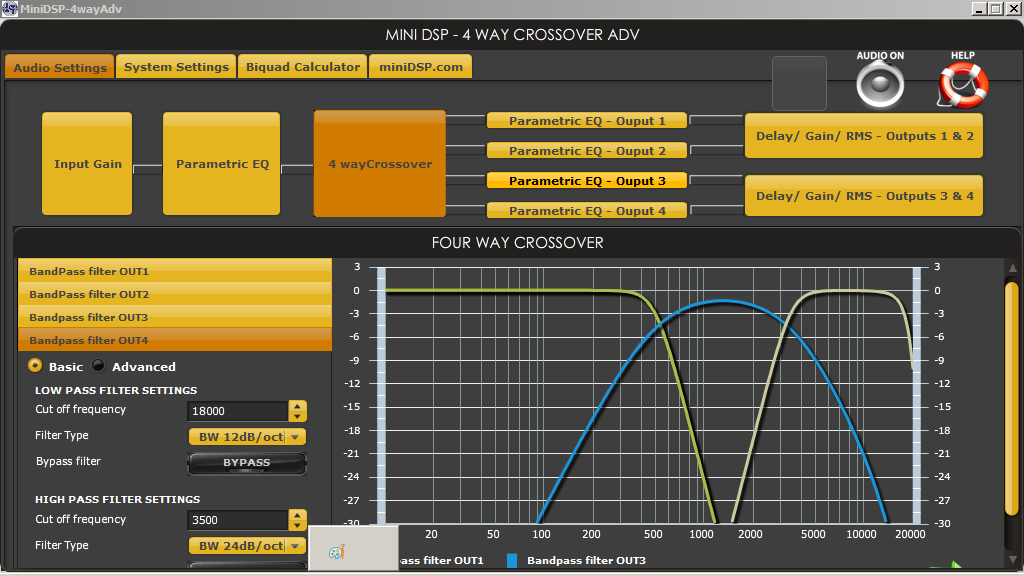
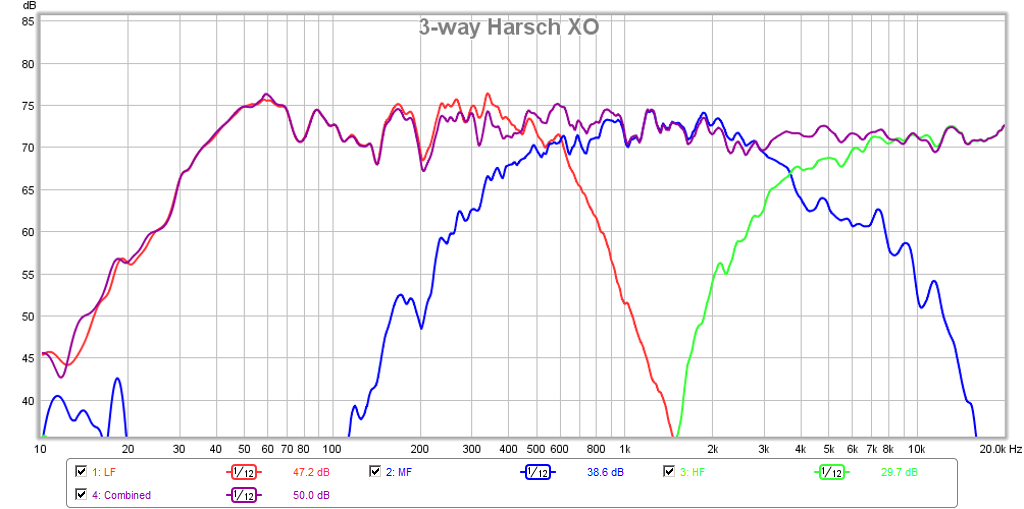
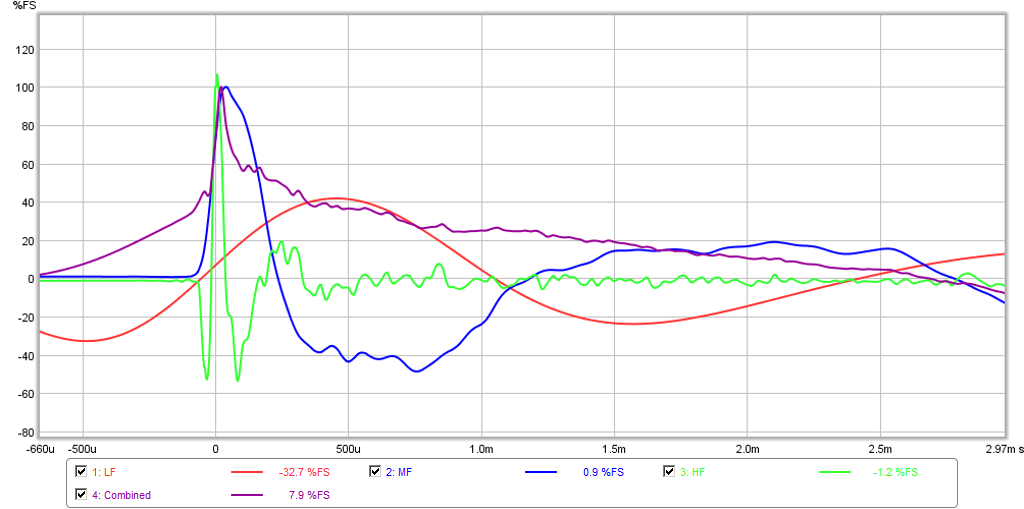
I am not even sure what to do for a 4-way. I think 4 way is not necessary.
Last edited:
As long as you cascade all filtering elements into every drivers response, response can be flat amplitude and phase. Had that problem with my 4-way, tackled it but problem is DSP are not ready for my filter style....
just powered 2 of minidsp 2x4HD to configure 3way as proof of concept and it works on basic setup. I have configured Crossover for Harsch but need to learn on manual FIR to setup the delay
Attachments
Last edited:
- Home
- Loudspeakers
- Multi-Way
- S. Harsch XO
